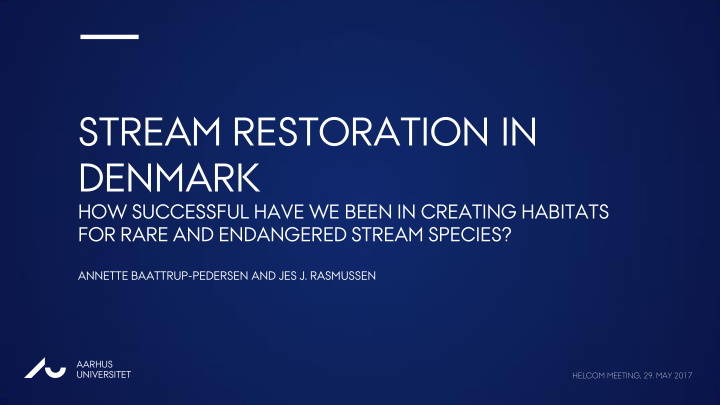



STREAM RESTORATION IN DENMARK n HOW SUCCESSFUL HAVE WE BEEN IN CREATING HABITATS FOR RARE AND ENDANGERED STREAM SPECIES? ANNETTE BAATTRUP-PEDERSEN AND JES J. RASMUSSEN AU AARHUS UNIVERSITET HELCOM MEETING, 29. MAY 2017
THE DIVERSITY IS HIGH IN FRESHWATER BUT MANY SPECIES ARE ENDANGERED The species diversity pr. area is higher in freshwater ecosystems compared to any other ecosystem on the earth The number of endangered species is much higher in freshwater compared to other ecosystems Gentegnet fra Strayer & Dudgeon (2010). J. N. Am. Benthol. Soc. AU AARHUS A. BAATTRUP-PEDERSEN HELCOM MEETING, 29 MAY 2017 UNIVERSITET
SPECIES IN THE GENUS POTAMOGETON ARE RAPIDLY DECLINING IN DANISH STREAMS The presence of Potamogeton was investigated on the same 13 sites in the three periods. Potamogeton praelongus Fram Baattrup-Pedersen et al. 2010. Vand og Jord . AU AARHUS A. BAATTRUP-PEDERSEN HELCOM MEETING, 29 MAY 2017 UNIVERSITET
REASONS FOR SPECIES DECLINE: HABITATS ARE LOST The total stream length in Denmark has been significantly reduced (40-50%) Some types of habitats are almost eradicated Backwater habitats and oxbow lakes The habitat diversity (riffle, run and pool) has declined. Riffle habitats have been lost. AU AARHUS A. BAATTRUP-PEDERSEN HELCOM MEETING, 29 MAY 2017 UNIVERSITET
WHAT ARE THE REASONS FOR SPECIES DECLINE: MANY STRESSORS There are many interacting stressors in streams: Hydrological alterations Nutrients and other pollutants like pesticides Weed cutting and dredging Straightening, widening and deepening of the stream channel and altered substrate characteristics Waste water Ochre … Gentegnet fra Dudgeon et al. (2006) : Biol. Rev. AU AARHUS A. BAATTRUP-PEDERSEN HELCOM MEETING, 29 MAY 2017 UNIVERSITET
HAVE WE BEEN SUCCESFUL IN STREAM RESTORATION PROJECTS IN DENMARK? AU AARHUS A. BAATTRUP-PEDERSEN HELCOM MEETING, 29 MAY 2017 UNIVERSITET
OVERVIEW – COMPARATIVE STUDIES Generally before-after studies are Based on comparative few and have only been performed studies over number and 1-2 years after the restoration abundance of endangered macroinvertebrate species Restoration succes has mostly been in 6 channelized, 6 natural and 6 restored streams in evaluated based on species richness, Denmark Danish Stream Fauna Index, and density of throut. The number and density of endangered species or species with a high conservation value have not been the focus Restoration succes has been limited if we consider the number of endangered species as a parameter Fra: Pedersen et al. 2014. Plos One for succes AU AARHUS A. BAATTRUP-PEDERSEN HELCOM MEETING, 29 MAY 2017 UNIVERSITET
EXAMPLE: SKJERN Å Restoration of River Skjern has created a number of new habitats. However, the stream width and the area with backwaters is still low and oxbow lakes are missing compared to former conditions (1871) The number of endangered macrophyte and macroinvertebrate species is lower than in the reference period (1942-1963). Species that are missing are those associated with backwater habitats and the river margin habitats. For the macrophytes app. 40% of the species are still missing when comparing to the reference period, especially Potamogeton species. Fra: Wiberg-Larsen et al. 2013. Vand og Jord AU AARHUS A. BAATTRUP-PEDERSEN HELCOM MEETING, 29 MAY 2017 UNIVERSITET
WHY IS RESTORATION SUCCES LIMITED WHEN IT COMES TO RARE AND ENDANGERED SPECIES? AU AARHUS A. BAATTRUP-PEDERSEN HELCOM MEETING, 29 MAY 2017 UNIVERSITET
ARE WE APPLYING APPROPRIATE METHODS? Addition of coarse substrata (stone and gravel) to the stream bottom is the most commonly applied restoration method in Danish streams This method also stabilizes the channel form and impede natural hydrodynamic processes in forming new stream habitats. AU AARHUS A. BAATTRUP-PEDERSEN HELCOM MEETING, 29 MAY 2017 UNIVERSITET
WHAT HAPPENS WHEN WE ADD COARSE SUBSTRATE ? • Some species like e.g. Regional species Heptagenia sulphurea (mayfly), pool Agapetus ochripes (caddisfly) and Elmis aenea (beetle) benefit from the created habitats • Habitats for macrophytes are Local missing species pool • Some species like e.g. Metretopus borealis (mayfly) associated with macrophytes will not benefit from the created habitats AU AARHUS A. BAATTRUP-PEDERSEN HELCOM MEETING, 29 MAY 2017 UNIVERSITET
THE NUMBER OF ENDANGERED SPECIES CONFINED TO COARSE SUBSTRATES IS LIMITED Approximately 25% of the endangered species are associated with gravel Half of the endangered species are more or less specifically associated with plants and woody debris Half of the endangered species are more or less specifically associated with bank and backwater habitats Approximately 25% of the endangered species occur only in bank and backwater habitats AU AARHUS A. BAATTRUP-PEDERSEN HELCOM MEETING, 29 MAY 2017 UNIVERSITET
RESTORATION PROJECTS MAY ALSO FAIL IF OTHER STRESSORS STILL OPERATE In a comparative study of plant communities in channelized, restored and natural reaches it was observed that weed cutting was the most important factor for species composition independent of the restoration performed If the proportion of streams with a high weed cutting intensity was left out of the analysis then habitat diversity (current velocity and substrate composition) turned out to be more important. AU AARHUS A. BAATTRUP-PEDERSEN HELCOM MEETING, 29 MAY 2017 UNIVERSITET
RESTORATION IN THE FUTURE AU AARHUS A. BAATTRUP-PEDERSEN HELCOM MEETING, 29 MAY 2017 UNIVERSITET
THE REFERENCE CONCEPT IN RESTORATION: Geology Stream slope and substrates Bio-engineering – macrophytes and dead wood Natural, dynamic processes that create habitat variability should be in focus Dead wood and macrophytes are natural bio- engineering elements in lowland streams and likely play an important role for the overall diversity AU AARHUS A. BAATTRUP-PEDERSEN HELCOM MEETING, 29 MAY 2017 UNIVERSITET
RESTORATION PRIORITIES Probably higher chance for success when restored stream reaches are situated in catchments with multiple source populations Restoration projects can then be planned to maximize the potential for dispersal succes to restored reaches AU AARHUS A. BAATTRUP-PEDERSEN HELCOM MEETING, 29 MAY 2017 UNIVERSITET
AU AARHUS UNIVERSITET
Recommend
More recommend